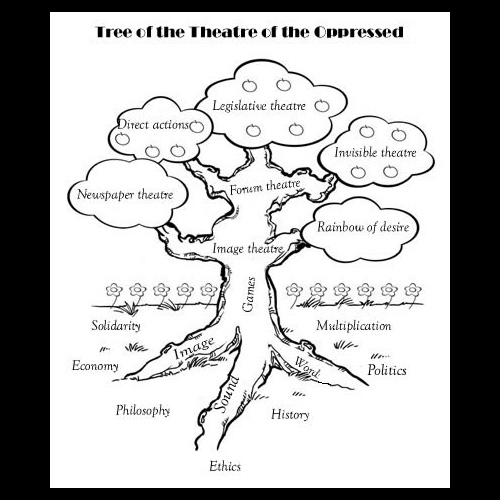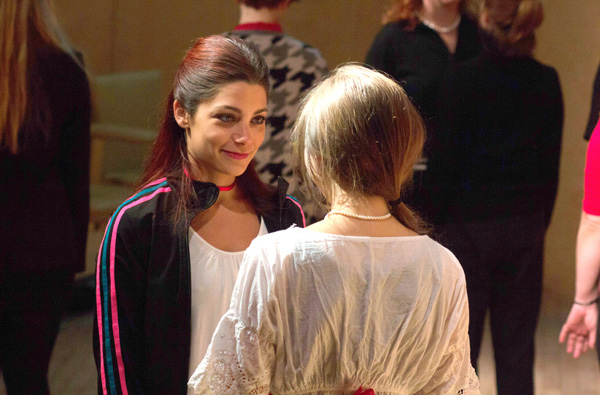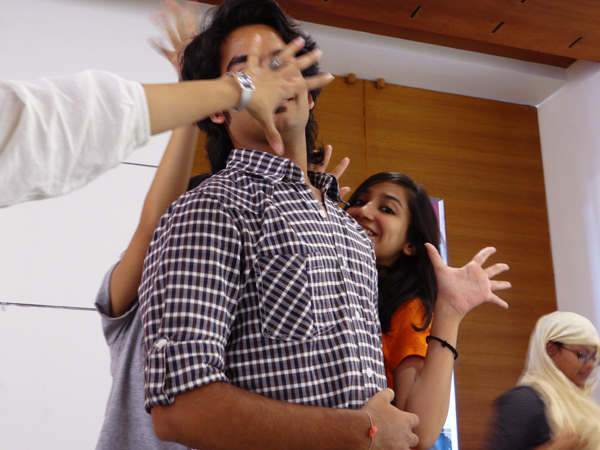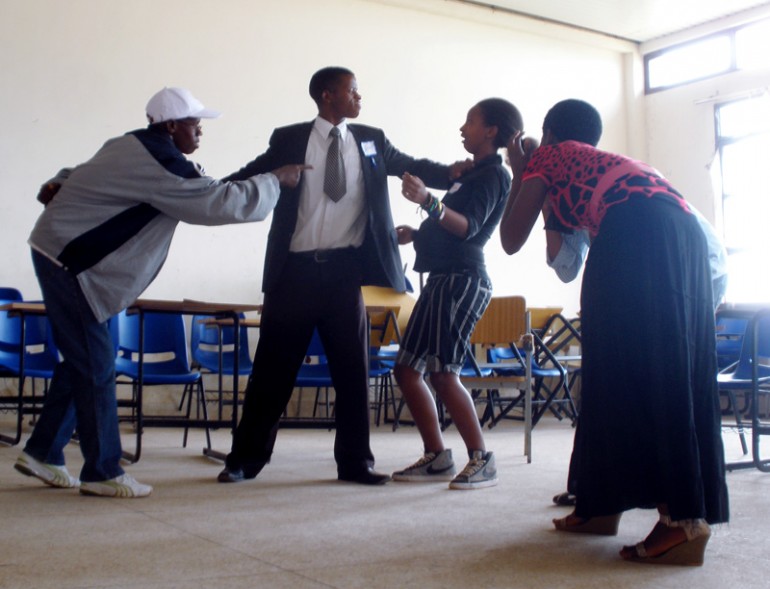Above: Photo from Praxistory/The tales and travels of an applied theatre artist, Amy Sayers. Theater of the Oppressed in Rwanda.
The activist’s tool belt is plentiful: fliers for educating, conversations for agitating, direct actions for challenging.
Theatre for creating. Theatre for exploring. All for empowering.
Recently, I attended the Montreal Student Movement Conference (MSMC) along with 10 other members of the Ohio University Student Union. The first session I attended was called “Forum Theatre.” None of us knew what that term meant, and consequently, no one was going to go. I figured at least one of us should, though, so I did.
I have learned vital information for the revolution.
There were about 12 other students in the room by the time the facilitator, Sean Estelle, walked in, sporting a Leftover Crack shirt.
He began explaining that Forum Theatre is a branch of something called Theatre of the Oppressed, which its founder, Augusto Boal described as “rehearsal for the revolution.” He described the audience as “spect-actors,” instead of “spectators.”
 Illustration from The Forum Project.
Illustration from The Forum Project.
I began to understand the meaning of the word “theatre” in “forum theatre.” I began to realize we would be acting and not simply sitting through a lecture. The walls of fear closed in on my chest, and my heart beat against them.
Shortly after, we started to tear those walls down. Estelle played light music in the background and instructed us to walk around the room, not looking at or talking to anyone. Then, he asked the unthinkable, the completely unreasonable and horrendously impossible: to make eye contact with those we passed.
Some people offered smiles as they passed me, though I had no idea how they could do so with seeming ease. I reciprocated, though I probably didn’t look as convincing. In hindsight, I recall a chest welling with fear and a face reluctant to look anywhere but down.
I also remember it slowly becoming easier by the time he asked us to partner up.
My partner ended up being someone named Connor Meston of the Michigan State University Student Union. We briefly introduced ourselves before the session, and that small connection is why we chose each other.
Awaiting instructions from Estelle, I felt tense again as I looked down and away from Meston. Eventually, Estelle’s next planned activity would push me completely past the walls of fear and offer liberation.
“Still without saying anything,” Estelle said, “look into your partner’s eyes, and don’t look away.”
Shit. A minute passed. More minutes passed. Fright and tenseness dissolved as small spurts of laughter crept in and comfort became the norm.
I found peace with a stranger. The tension, the struggle: they washed away, and we were in harmony. This was rehearsal for the revolution.
 Photo from International Filmakers Guild of Korea Explore all possibilities: An Introduction to Boal’s “Theatre of the Oppressed”
Photo from International Filmakers Guild of Korea Explore all possibilities: An Introduction to Boal’s “Theatre of the Oppressed”
The walls of fear were uprooted, replaced by the foundation of trust. Estelle instructed us to once again walk through the room in silence while making eye contact with those around us. I walked with my eyes looking forward, acknowledging and smiling at anyone and everyone. It was like Emma Goldman’s description of anarchy: the harmony between our need for individual freedom and our place within the social world.
The foundation was firm, and now the real work could begin.
First, we conducted an exercise wherein we formed two lines of people with a facilitator on one end and a spect-actor on the other. Once it was someone’s turn, that person was instructed to run blindly with shut eyes to the facilitator.
A couple of people made it to the end, but mostly people looked a bit like I did.
I closed my eyes and convinced myself that I was confident, but not too confident, and therefore, I would succeed. Running with fury for maybe one second that felt like forever, I was stopped by my expectations. How was I not at the other end yet? I was afraid of knocking down the facilitator, not trusting her strength and ability to stop me.
I feebly made my way to the end of the line and stood in self-judgment of myself, but I joined the others in applauding each time someone failed to make it to the end, and then I realized no one else was judging me. It didn’t matter. We were building a support system of trust amongst ourselves.
Estelle said to observe how our bodies reacted as we ran to better understand our bodies for what was to come.
. . .
We split into two groups, one on each side of the room, and were instructed to create still poses with our bodies which people would react to with poses of their own. At first, three to four people would be posing at any given time.
Eventually, we moved into repetitive moving poses, but still allowed to use still poses. The limit of three to four people was lifted and we were allowed (but not required) to involve everyone in our image.
Then we were instructed to act as students. Some imitated writing on a chalkboard or carrying a backpack. Others were told to act as university administrators, which is when things got interesting. Some administrators simply observed and took note of students while others interrupted their activities, one with an authoritative hand in front of a student’s face.
 Photo from Alliance Française,International Theatre Workshop on Forum Theatre.
Photo from Alliance Française,International Theatre Workshop on Forum Theatre.
We continued to react to repression, always searching for new ways to fight back.
All of this was buildup to the climactic short play we were to build together.
Everyone partnered up again to create two-person poses, one person acting as an administrator and one as a student. We chose one pose to be the foundation of our play.
The pose we chose happened to be the one my partner and I constructed: I, playing the student, was kneeling down attempting to retake my my red, felt square—a symbol of solidarity within the student movement—from underneath the administrator’s foot.
We decided this pose would be the middle of the play, and we collaboratively created the beginning and ending poses. The end product was as follows:
Student: [Walking with red square hanging out of pocket]
Administrator: [Attempts to grab red square from behind, but it falls on the ground]
Student: [Stops walking] Hey. It feels like something’s missing. [Turns around]
Administrator: What are ya doing with this, ya commie?
Student: Hey, man, I’m just a human like you. [kneels down to grab red square]
Administrator: You shouldn’t be learning about things like this! [steps on red square and winds up to punch student in the face]
Administrator: [Steps on open safety pin that is attached to red square; falls] Yeeaaaooooowwww!
Student: [Grabs red square; shows it to the audience] Student power strikes again!
[End]
We ended the session by having most spect-actors create a machine with our bodies that a few outsiders disrupted somehow until the machine no longer worked.
Forum Theatre may have been one of the most fun and practical things I learned at the MSMC, and I plan to bring it back to my university. I encourage others to use this article as a template to try it in your own communities. Bottom-up democracy is going to require strong communities whose members can take the initiative to act in favor of the people’s interest. It will require the demolition of fear and the building of courage. We have to be able to imagine the sort of world we want to live in, and we have to be prepared to build it in spite of those who would like to keep the walls of fear intact.
Rehearse. Act. Mobilize to win.






